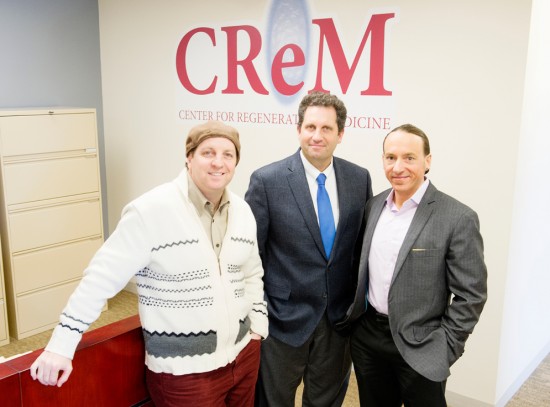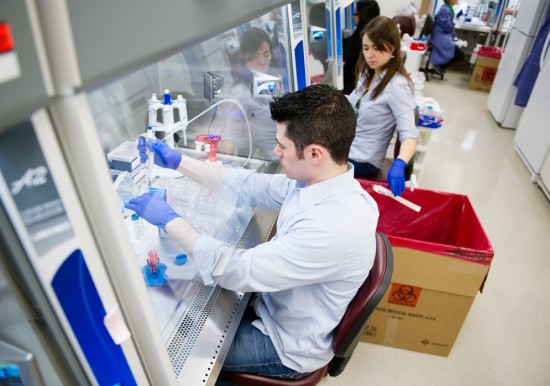Regenerative Medicine Generates Hope
Egos in BU center take a backseat to sharing, progress, and promise
In the video above, CReM founders Darrell Kotton, Gustavo Mostoslavsky, and George Murphy discuss how they use iPS cells to study disease development, conduct drug screenings, and eventually to correct genetic mutations, with the goal of producing healthy tissues and organs for transplantation. Photo by Jackie Ricciardi
“Our mission is to decrease the burden of human suffering on the planet, help patients, and advance new knowledge.” —Darrell Kotton
With the motto Advancing Science to Heal the World the BU stem cell scientists who founded the Center for Regenerative Medicine (CReM) could be pegged as starry-eyed idealists or scientific superheroes. Or perhaps a bit of both.
CReM codirectors Darrell Kotton, Gustavo Mostoslavsky, and George Murphy have established themselves as venturesome researchers who are willing to share their discoveries with almost anyone. And they do it for free—bucking the prevailing trend to patent, publish, and protect scientific breakthroughs. The trio’s “open source biology” is just one of the things they teach to the next generation of stem cell researchers at CReM.
Open source biology can seem antithetical to scientists in an extremely competitive field. One young researcher training at CReM recently approached Kotton, a School of Medicine professor of medicine, seeking advice on how to answer an outside request for a vial of stem cells that took several years and hundreds of thousands of dollars in federal grants to develop. The obvious answer, the trainee assumed, was to tell the researcher to wait until the discovery was published.
Kotton saw it differently. “Our mission is to decrease the burden of human suffering on the planet, help patients, and advance new knowledge,” Kotton reminded him. “If this competitor of ours has the same goal, then we’re obligated to share this cell vial with them, because that’s going to achieve our mission.…which is not to get credit and to stroke our egos.”
A naïve response? “Here’s the thing that nobody talks about,” says Kotton. “If you behave in this way, people in our community quickly get the idea that the BU-BMC CReM are the good guys of science. At some point, the equation gets so lopsided that people almost feel embarrassed that they’re not sharing with you and so they tell you stuff, and the whole field starts to move forward.”
In fact, CReM founders say that increasing numbers of researchers are asking CReM to collaborate on grants, and foundations have begun to recognize that funding a CReM project very probably means that resulting knowledge, expertise, and reagents will be shared with other academic or nonprofit laboratories without restriction or exclusivity.
“I can’t emphasize enough how unique that was for the community,” says Mostoslavsky, a MED assistant professor of gastroenterology. “We have dozens of emails that testify to that, saying, ‘I must tell you this is the first time in my 30 years of being a scientist that someone replied and sent me stuff the same week of asking for it.’”
Still, Mostoslavsky says, there is a “fine balance that is not easy to achieve” between freely sharing their work and protecting it once research has advanced to the clinical stage. “That is a major undertaking,” he says. “It’s very expensive—no academic institution can support it—so we do need a company to move forward,” which also means they’ll need patented protection of intellectual property.

Scientific soul mates
Kotton, Mostoslavsky, and Murphy met as Harvard postdoctoral fellows in the lab of renowned stem cell scientist Richard Mulligan, who is famous for his rigorous research and forthright style of mentorship. “It was more of a sink-or-swim methodology, where you really had to prove yourself,” says Murphy, a MED assistant professor of medicine. “Coming out of there, we were battle-tested and bombproof.”
The three gravitated toward each other as “scientific soul mates,” Mostoslavsky says. Long after fellow researchers had left the lab, they would gather for late-night pizza and animated discussions, probing one another’s data to test the strength of their work. “We were each other’s worst critics as well as biggest fans,” Kotton says. It was around that time that they began toying with the idea of conducting science their way—in a meticulous, yet open and collegial manner.
After completing his Harvard fellowship, in 2006 Kotton returned to MED, where he had done a fellowship previously, to launch his own lung stem cell lab. He confesses to “putting psychological pressure” on his friends to follow him to BU, and he is not at all unhappy that it worked. In 2008, Mostoslavsky came aboard, creating his own lab. He was followed soon after by Murphy.
Several events conspired to launch CReM on the Medical Campus. The founders discovered a strong advocate in David Coleman, Wade Professor and chair of the MED department of medicine, who emphasized the importance of a robust research presence on the Medical Campus. Kotton, Mostoslavsky, and Murphy had followed closely the rapid advance of stem cell biology since 2006, when scientists at the University of Kyoto developed induced pluripotent stem cells (iPS) by reprogramming an adult differentiated cell. A tinkerer at heart, Mostoslavsky was fascinated by the Kyoto process, but felt he could go one better. In 2008, he developed a more efficient tool to generate stem cells, called the stem cell cassette (STEMCCA). BU patented the tool, which has become industry standard.
In 2010, with STEMCCA and multiple publications under their belts, the trio established a virtual Center for Regenerative Medicine, with its own website, seminar series, and iPS cell bank carrying branded labels. All this was accomplished while working in separate labs, with Murphy’s and Mostoslavsky’s divided by floors within a building, and Kotton’s located across the street.
As the number of stem cell biologists, physician-researchers, and biomedical engineers grew on both BU campuses, the affectionately labeled CReM brothers felt it was time to pitch a physical center to BU President Robert A. Brown, who firmly backed the idea. Boston University and Boston Medical Center invested jointly in the endeavor, and in November 2013, CReM opened in its newly remodeled space on the second floor of 670 Albany Street.
In the video above, CReM founders discuss how they use induced pluripotent stem (iPS) cells in their labs.
Clinical trial in a test tube
CReM’s mission is to advance stem cell research and regenerative medicine for the treatment patients, in particular those at BMC, with diseases such as cystic fibrosis, emphysema, sickle cell anemia, and amyloidosis. Investigators collect blood or skin cell samples, usually from patients at the Alpha-1 Center, the Center of Excellence in Sickle Cell Disease, and the Amyloid Center, and reprogram them into iPS cells.
“Any cell can be reprogrammed,” says Mostoslavsky. “It’s a true biological rejuvenation. The cells really go back in time.” Researchers now have the ability to coax iPS cells—which uniformly carry a patient’s genetic mutations—into their desired cell line, such as lung, liver, or blood. (CReM’s iPS cell bank stores at least 13 such cell lineages.) Mostoslavsky says the resulting cells are “still a work in progress,” compared to those found in nature, but the process allows researchers to watch how an iPS-derived lung cell develops the early stages of cystic fibrosis. What took years to unfold in a patient takes days in the lab.
CReM investigators can screen drugs against patient cell lines to determine which medications are most effective for a specific genetic mutation—the “clinical trial in a test tube,” as Murphy calls it. “In theory,” he says, “you could develop therapies that are molded specifically for a particular patient with a particular disease.”
Developmental biology and drug screenings are now CReM’s bread and butter, but its founders keep in mind what they call their long-term “Apollo projects,” such as genetically engineering iPS cells to correct patients’ mutations. The resulting healthy cells could be cultured and multiplied to regenerate a transplantable organ that wouldn’t be rejected by the patient’s body. That particular medical breakthrough would mean Kotton’s wife would need to look for a new job. Camille Kotton is a transplant infectious disease physician at Massachusetts General Hospital, and Kotton jokes that his “goal is to put her out of business.”
Kotton has been collaborating with a team of MGH researchers using a technology called lung decellularization and recellularization, which strips the organ of its cells and repopulates it with genetically engineered copies that lack the patient’s original mutation. Theoretically, the reprogrammed cells could multiply, fill the lung’s scaffolding, and someday be used for transplantation.
Kotton, who thinks it will be possible eventually to re-create lungs via 3-D printing technology, is collaborating on this with Christopher Chen, a College of Engineering professor of biomedical engineering.
Meanwhile, Murphy dreams of brewing blood. “The human body makes 2.5 million red blood cells every second of every day,” he says. “How does one contend with that from a research platform?” He thinks they will be able to “harness molecular cues” that exponentially increase the amount of artificial blood they can produce in vitro. Such a discovery could eliminate the need for blood donation in the United States and—even more urgent—in Third World countries, where the practice is not widely accepted.
Another of Murphy’s Apollo projects is boutique blood, or the development of small batches that could be produced for people who suffer from sickle cell anemia or the blood disorder beta thalassemia and require transfusions of rare blood types.

Researcher as healer
In the past four years, word has spread about the CReM founders’ work to the point that as well as the emails from potential collaborators who want access to their work, they now get email from patients who either suffer from the particular disorders they study or have children who do.
The latter are heartrending. “‘We will sign whatever you want us to sign, and we don’t care how experimental your platform is, we would still like to use it to save our kid,’” Murphy recalls reading. He explains that although his team is working hard to find new treatments, right now there are no current stem cell therapies for their child’s condition. Asked when they might be available, he replies, “‘Sooner than you think.’ That’s vague, but it’s hopeful. And it also is the way that we see things.”
Kotton likes to tell a story that underscores CReM’s potential. He and his colleagues were approached about a child who suffered from severe cardiac arrhythmias. Their labs developed iPS cells from the boy’s skin cells and differentiated them into heart muscle cells, then sent them to researchers in New York City, who screened them against a series of drug regimens until they found a winning combination. After three months on the medication, the boy’s arrhythmia decreased from 100 incidents per month to zero.
“This success story represents, I believe, the first human being on planet Earth to be helped by the new iPS cell technology,” Kotton says. “If there is one patient who can benefit from these cells, then surely there are myriad more for generations to come.”
This BU Today story was written by Leslie Friday. Videos by Joe Chan